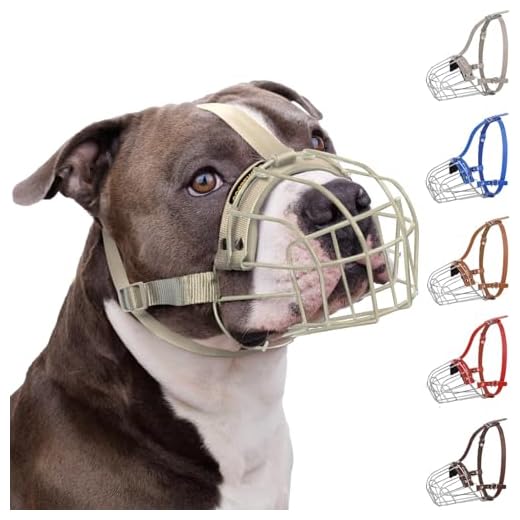








Using a muzzle can significantly enhance safety for both your pet and those around them. I discovered this firsthand during a visit to the dog park with my furry friend, Max. He’s usually well-behaved, but one day, he got a bit too excited and started barking aggressively at another dog. A simple muzzle not only calmed him down but also reassured other pet owners.
Another advantage lies in veterinary visits. I remember when Max needed a routine check-up, but he became anxious and nippy at the clinic. The vet recommended a soft muzzle to keep everyone safe while still allowing for examination and treatment. This measure made a stressful situation much easier for everyone involved.
Moreover, certain breeds have a natural predisposition to being more protective or territorial. For instance, larger breeds can sometimes intimidate passers-by. A muzzle can prevent any misunderstandings, allowing your pet to enjoy walks without raising concerns from others. My neighbour’s Rottweiler wears a muzzle during outings, and it has turned into a social icebreaker rather than a point of fear.
Additionally, there are scenarios where a muzzle can prevent unwanted chewing or eating of harmful substances. During our daily walks, I’ve seen Max sniff around for things he shouldn’t touch. A muzzle can act as a safeguard, allowing him to explore his environment safely without the risk of ingesting something dangerous.
Overall, incorporating a muzzle into your dog’s routine can enhance safety, promote positive interactions, and alleviate anxiety during stressful situations. It’s not just about prevention; it’s about ensuring a harmonious experience for everyone involved.
Preventing bites in stressful situations
Using a muzzle during high-pressure moments can significantly reduce the risk of bites. I’ve seen it firsthand; my own pup, Max, tends to react poorly to loud noises and sudden movements. The first time we encountered a thunderstorm, I noticed how anxious he became. It was a turning point for me. Realising that I needed a solution, I opted for a comfortable muzzle. This simple tool helped keep Max calm and others safe, allowing us to get through the storm without incident.
Training with a muzzle
Introducing a muzzle to your pet should be a gradual process. I started by letting Max wear it for short periods, rewarding him with treats. This approach not only desensitised him to the muzzle but also created a positive association. In stressful environments, like busy parks or vet visits, he wore it with ease, which in turn calmed my nerves, knowing he couldn’t bite out of fear or anxiety.
Choosing the right type
Selecting the appropriate style is crucial. I found that basket muzzles are ideal for situations where my dog still needs to breathe comfortably and drink water. For Max, this meant he could pant during stressful moments, which helped him manage anxiety better. It’s important to ensure that the fit is snug but not too tight, allowing for natural movement without compromising safety.
Ensuring safety during vet visits
Using a face guard can significantly enhance safety during trips to the veterinary clinic. These visits often provoke anxiety in pets, and a secure fitting muzzle can prevent unexpected reactions that might lead to harm.
Here are some practical tips to ensure a smooth experience:
- Familiarisation: Before the appointment, allow your furry friend to wear the muzzle at home. This reduces fear and helps them associate it with positive experiences, such as treats or playtime.
- Proper fit: Ensure the muzzle fits well. It should be snug but not too tight, allowing your pet to breathe comfortably and drink water. Measure your dog’s snout carefully and choose a design that suits their breed.
- Calm environment: On the way to the clinic, keep the atmosphere calm. Play soothing music or talk gently to your pet. This can help reduce stress levels, making the visit less intimidating.
- Positive reinforcement: Bring along some of their favourite treats. Reward them for wearing the muzzle and for good behaviour during the visit. This creates a positive association with the experience.
Even with a muzzle, it’s important to monitor your pet’s body language. Signs of extreme distress might require you to take a step back and reassess the situation. Not all dogs react the same way, and what works for one might not work for another. In case you notice unusual behaviour, consult with your vet for tailored advice.
Additionally, if you’re facing issues with your pet’s eating habits, it’s worth exploring why wont my dog eat his new food. Understanding their preferences can make a significant difference in their overall wellbeing.
Aiding in the management of aggressive behaviour
Implementing a muzzle can significantly assist in controlling aggressive tendencies during training sessions or social interactions. It serves as a preventive measure, allowing for a safer environment for both the canine and surrounding individuals. I once had a friend with a large breed that showed signs of aggression when confronted by unfamiliar dogs. By introducing a muzzle, he managed to engage his pet in socialisation exercises without the constant worry of potential harm.
In situations where a pet may feel threatened or anxious, such as crowded parks or during specific encounters, a muzzle can effectively reduce the likelihood of aggressive outbursts. This tool allows owners to gradually desensitise their pets to stressful stimuli, fostering a calmer temperament over time. A neighbour of mine used this approach with her rescue dog, who initially reacted fearfully to strangers. The gradual acclimatisation process, aided by a muzzle, transformed her pet into a more sociable companion.
Additionally, a muzzle can be a helpful tool during training sessions focused on addressing aggressive behaviour. It provides a layer of security that permits trainers to work on behavioural modification strategies without the risk of bites. I’ve seen trainers utilise this method with great success, slowly building trust and reducing aggressive responses through consistent, positive reinforcement techniques.
Ultimately, the key is to ensure that any muzzle used fits comfortably and allows for proper panting and drinking. This consideration is vital to maintain the pet’s comfort and well-being during the training and socialisation process. A snug yet breathable option can make a significant difference, as my own experiences have shown the importance of keeping the canine relaxed while learning.
Facilitating safe interactions with other animals
Using a face guard can significantly enhance safety during encounters with unfamiliar pets. I remember the first time I took my Labrador, Max, to the dog park. He was eager to play but very enthusiastic, which made some other dog owners nervous. By having him equipped with a suitable face guard, I was able to reassure others that he wouldn’t unintentionally nip out of excitement. This simple measure made interactions smoother and more enjoyable for everyone involved.
Building trust with other pet owners
When you introduce a face guard, it sends a clear signal to fellow pet owners that you are proactive about safety. This can foster trust and encourage open communication. At a local meet-up, I found that many owners felt more at ease approaching me after they noticed Max was wearing his face guard. They were more willing to let their dogs interact with him, knowing I was taking precautions.
Encouraging positive social experiences
Positive interactions can greatly influence a pet’s behaviour. For instance, I often noticed that after several successful meet-and-greets while wearing a face guard, Max became more relaxed around other animals. This gradual exposure helped lessen his initial excitement and anxiety during encounters. It’s fascinating how a small piece of equipment can play a significant role in shaping positive behaviours and socialisation skills.
Reducing the risk of scavenging harmful substances
Using a muzzle can significantly lower the chances of your furry friend ingesting dangerous items found on walks or in parks. I recall a time when my dog, Max, stumbled upon something that looked like a tasty treat, but I was sceptical. Thankfully, he was wearing a muzzle, which prevented him from gobbling it up before I could intervene.
Many pets are natural scavengers, often sniffing around for anything edible. This behaviour can lead to ingestion of toxic substances, such as discarded food, rotten items, or even harmful materials like glass. A muzzle acts as a safety net, restricting access to their mouths while still allowing them to breathe comfortably and pant.
When out and about, keep an eye on your canine companion. If you notice them showing interest in something on the ground, you can feel assured that the muzzle will keep them from accidentally consuming something harmful. It’s not just about preventing bites; it’s also about safeguarding their health.
Additionally, using a muzzle during training sessions can help create a controlled environment where you can teach your pet to ignore unwanted food items. This proactive approach not only protects their well-being but also fosters better habits in the long run.
Incorporating a muzzle into your dog’s routine can be a simple yet effective way to mitigate risks associated with scavenging, ensuring a safer experience for both of you during outdoor adventures.








